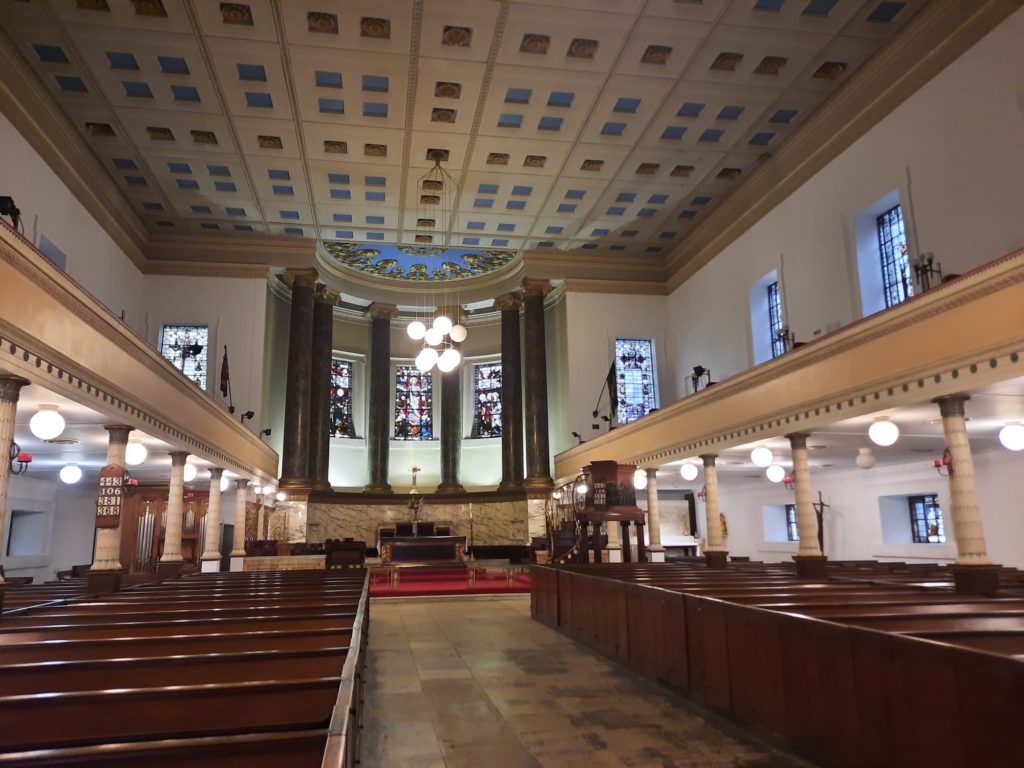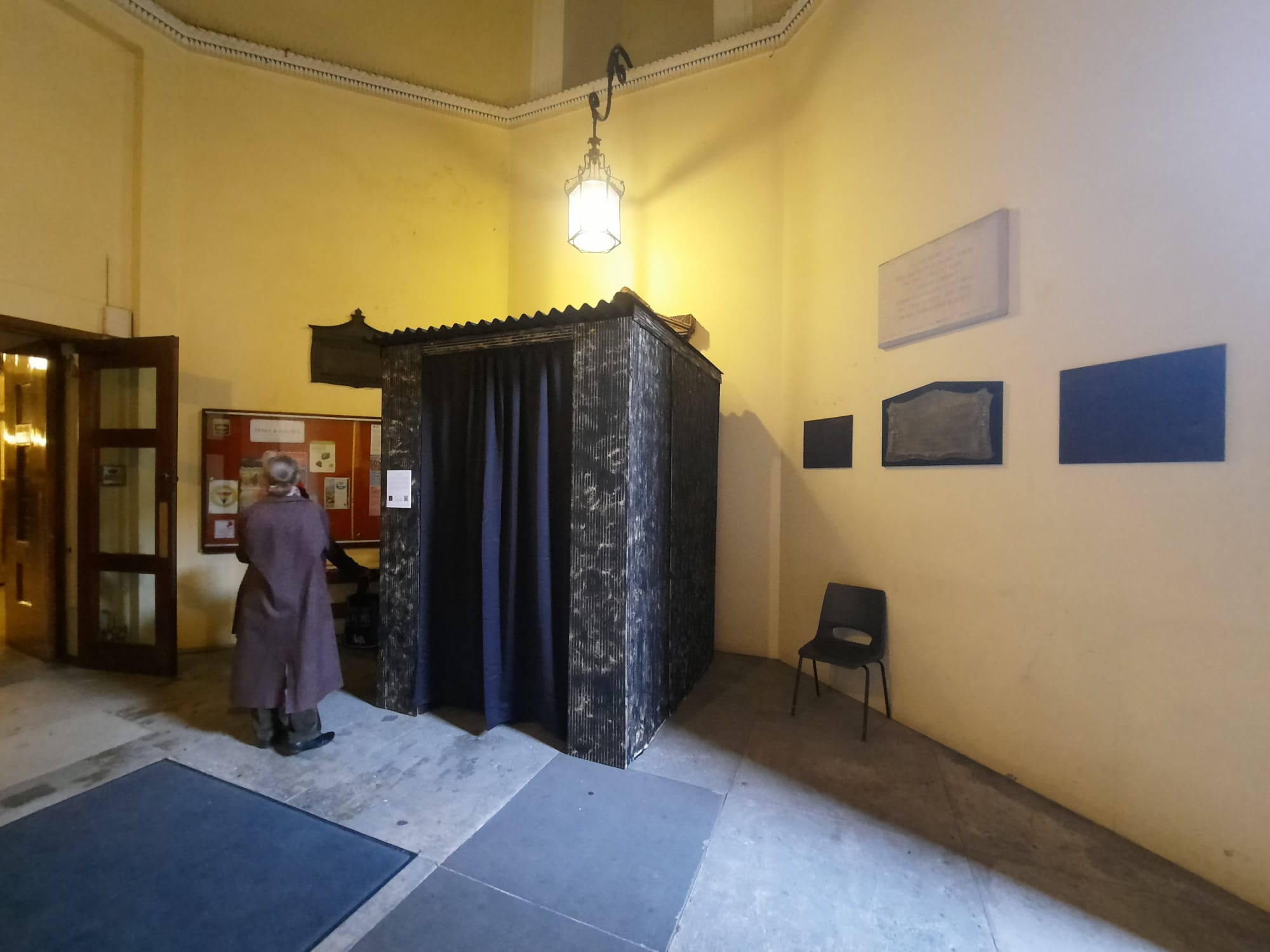A Room Of One’s Own – Giuseppe Mario Urso / Bloomsbury Festival 2023
A video installation inside St Pancras New Church, A Room of One’s Own reminds us to take stock of our lockdown experience for good and ill.

A Room Of One’s Own
This is today’s second Bloomsbury Festival post. A double bill, if you will, which gives a taster of just some of what’s on offer. In the first post we looked at corporeal mime performance Rey Camoy. And in our second we will take in A Room of One’s Own, an art installation by Giuseppe Mario Urso at St Pancras New Church. We saw his work A Lump in the Throat as part of last year’s festival.
The Bloomsbury Festival, a fixture on the London calendar since 2006, has a natural literary connection. Bloomsbury has long been associated with literature, with many publishing houses based here as well as the Bloomsbury Group, the intellectual, artistic and literary circle which included Virginia Woolf, her sister Vanessa Bell, E.M. Forster, and John Maynard Keynes among others. The Bloomsbury Festival, which is ‘a creative explosion of arts, culture and science’ is much broader than what the Bloomsbury Group may bring to mind. It’s about Bloomsbury as a cultural quarter, showcasing its diverse communities and creating inspiration through new projects in different media.
Nonetheless, I ask readers to indulge me while I come back, for a moment, to the Bloomsbury Group. It’s for a very good reason. To those who have read some Woolf, studied English literature or feminism, or have good general knowledge, the title of Urso’s work will be familiar. A Room of One’s Own is also the title of Woolf’s 1929 essay, based on two lectures she delivered to women’s colleges in Cambridge. In it she sets out the argument that it is not a lack of talent but a lack of opportunity that has stifled women’s creative output (specifically writing). Essentially, the bare minimum in order to be able to unleash one’s potential is a place in which to think (the room of one’s own), and the means to support oneself.

Connecting Past And Present
Just what does Virginia Woolf’s work have to do with the artwork in question? At first glance, the two works do not share more than a title (and perhaps a location). Urso’s work stands in the vestibule of St Pancras New Church. It looks very much like a confessional: a formal black box closed off with a curtain. For those willing to peep inside, however, it is immediately apparent that this is something very different.
Video screens on three walls and the ceiling encompass the viewer. As the footage begins, it is clear this is not an ordinary experience, or perspective. Urso, in a face mask, appears to gently remove us from a box. He proceeds to carry us through normally private spaces, up to the church’s roof. At the end we are gently placed back inside and return to darkness. It’s an experience to be shared with at most two to three companions, and lasts no more than five minutes.
Emerging from the darkened space of the faux-confessional, it’s now time to do the work to think about what you’ve just experienced. Urso’s intent is to create a liminal space. If you’re not familiar with the term then suffice it to say a connecting space or time between two moments. Like waiting in a hallway or for a flight. Full of potential, without knowing what will happen next. And there is a real oppositional tension in the work which supports this intent. A small, confined space which, once inside, opens out beyond its own walls. An experience in which we feel small and powerless, subject to the artist’s whims, and yet emerge with a sense of calm. It’s amazing what a few short minutes can do.

Art As Therapy
In an interview with Bloomsbury Radio, Urso also talks about the power of art as therapy. A Room of One’s Own is a meditation on lockdown. It encourages us to acknowledge this experience, to let go what we do not need to take forward from it, but also to remember the positives. This is an interesting dichotomy, and again a concept which manifests relatively simply in this installation. Our journey through the church with Urso reminds us of the many wonderfully creative ways in which art and artists brought the outside world to us through technology when we were stuck at home. We were privileged to have access to this, and must remember the power of opening up new experiences to those who can’t physically experience them.
At the same time, A Room of One’s Own encourages us to let go. To leave behind the parts of our lockdown experience we can now leave behind. Leaving the confessional we can step into the church, or outside onto the streets of Bloomsbury. The world is open once more, and new experiences are ours for the taking. The relaunch of the Salterton Arts Review hopefully shows how I’ve tried to embrace this potential. But I must remember to be cognizant that it is lockdowns that brought me to this point.
Looking back, then, at the work’s title and its connection to echoes of Bloomsbury’s past, just what do Virginia Woolf and Giuseppe Mario Urso’s works have in common? At their core, I would say a reminder of how little we seem to need in order to harness our creativity and reach our potential, but how challenging it can sometimes be to create those conditions for ourselves.
A Room of One’s Own is free to visit, with no booking system in place. Simply walk into St Pancras New Church during its opening hours (11AM to 2PM) until 22 October.
Salterton Arts Review’s rating: 3.5/5
A Room of One’s Own on as part of Bloomsbury Festival 2023 until 22 October
If you see this after your page is loaded completely, leafletJS files are missing.

